

Compact Muon Solenoid
LHC, CERN
| CMS-B2G-16-025 ; CERN-EP-2017-272 | ||
| Search for pair production of excited top quarks in the lepton+jets final state | ||
| CMS Collaboration | ||
| 29 November 2017 | ||
| Phys. Lett. B 778 (2018) 349 | ||
| Abstract: A search is performed for the pair production of spin-3/2 excited top quarks, each decaying to a top quark and a gluon. The search uses the data collected with the CMS detector from proton-proton collisions at a center-of-mass energy of 13 TeV, corresponding to an integrated luminosity of 35.9 fb$^{-1}$. Events are selected by requiring an isolated muon or electron, an imbalance in the transverse momentum, and at least six jets of which exactly two must be compatible with originating from the fragmentation of a bottom quark. No significant excess over the standard model predictions is found. A lower limit of 1.2 TeV is set at 95% confidence level on the mass of the spin-3/2 excited top quark in an extension of the Randall-Sundrum model, assuming a 100% branching fraction of its decay into a top quark and a gluon. These are the best limits to date in a search for excited top quarks and the first at 13 TeV. | ||
| Links: e-print arXiv:1711.10949 [hep-ex] (PDF) ; CDS record ; inSPIRE record ; CADI line (restricted) ; | ||
| Figures | |
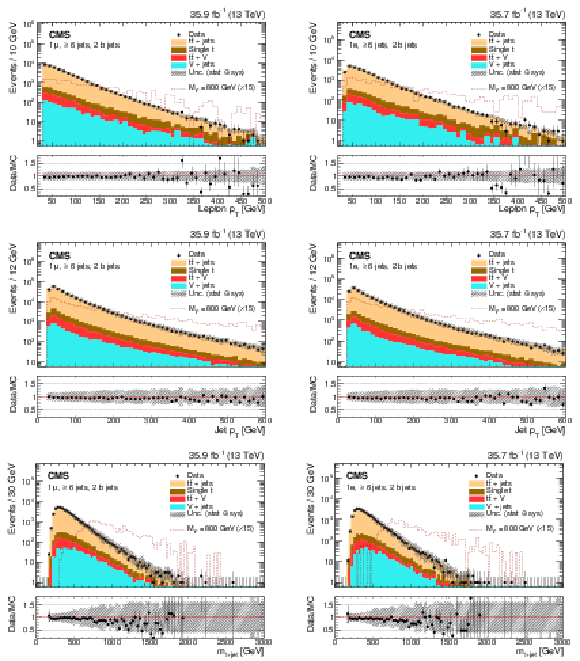
png pdf |
Figure 1:
Kinematic distributions of selected events with a single lepton and six or more jets of which exactly two are b tagged. Data events (points), simulated background processes (stacked histograms), and a simulated 800 GeV signal process (dashed line) are shown. Events selected in the $\mu $+jet final state are shown on the left while those in the e+jet final state are shown on the right. From upper to lower, the kinematic variables displayed are the lepton $ {p_{\mathrm {T}}} $, the jet $ {p_{\mathrm {T}}} $ and the $m_{\rm t+jet}$. The shaded region is the total uncertainty of the simulated background processes, which includes statistical and systematic uncertainties. |
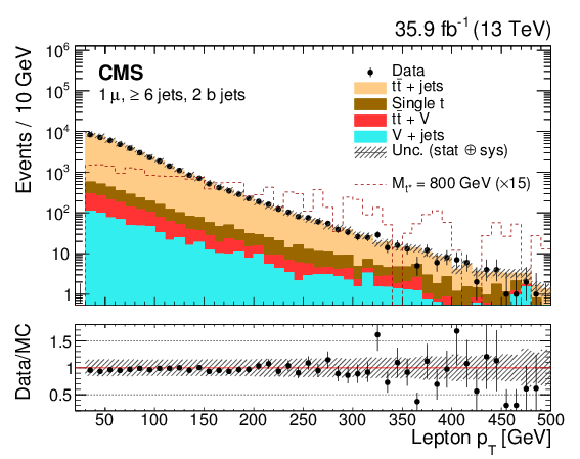
png pdf |
Figure 1-a:
Lepton $ {p_{\mathrm {T}}} $ distribution of selected events with a single muon and six or more jets of which exactly two are b tagged. Data events (points), simulated background processes (stacked histograms), and a simulated 800 GeV signal process (dashed line) are shown. The shaded region is the total uncertainty of the simulated background processes, which includes statistical and systematic uncertainties. |

png pdf |
Figure 1-b:
Lepton $ {p_{\mathrm {T}}} $ distribution of selected events with a single electron and six or more jets of which exactly two are b tagged. Data events (points), simulated background processes (stacked histograms), and a simulated 800 GeV signal process (dashed line) are shown. The shaded region is the total uncertainty of the simulated background processes, which includes statistical and systematic uncertainties. |
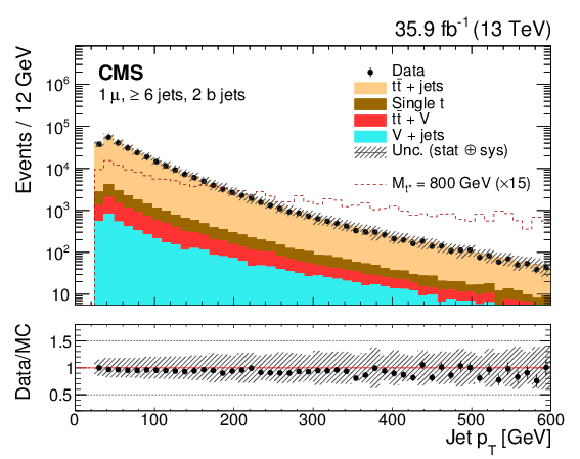
png pdf |
Figure 1-c:
Jet $ {p_{\mathrm {T}}} $ distribution of selected events with a single muon and six or more jets of which exactly two are b tagged. Data events (points), simulated background processes (stacked histograms), and a simulated 800 GeV signal process (dashed line) are shown. The shaded region is the total uncertainty of the simulated background processes, which includes statistical and systematic uncertainties. |
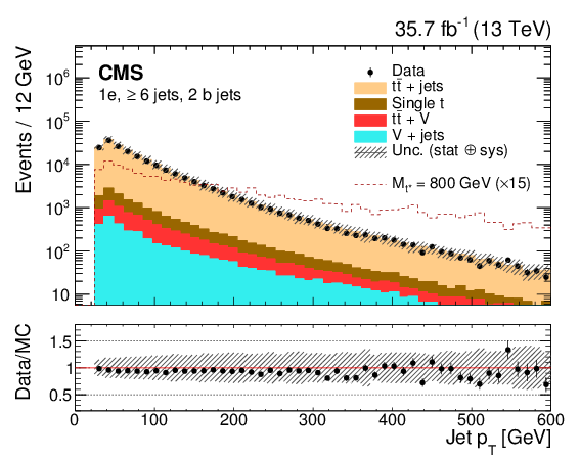
png pdf |
Figure 1-d:
Jet $ {p_{\mathrm {T}}} $ distribution of selected events with a single electron and six or more jets of which exactly two are b tagged. Data events (points), simulated background processes (stacked histograms), and a simulated 800 GeV signal process (dashed line) are shown. The shaded region is the total uncertainty of the simulated background processes, which includes statistical and systematic uncertainties. |
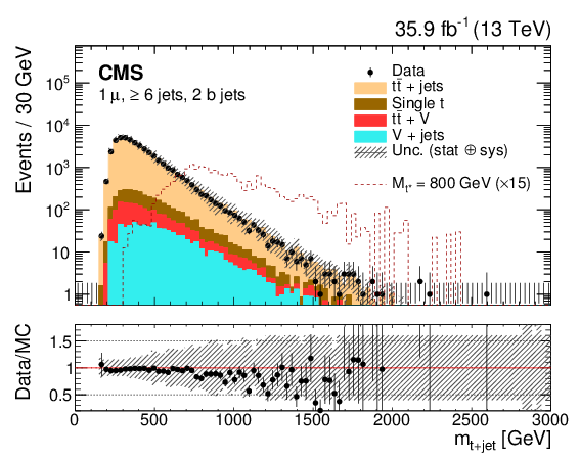
png pdf |
Figure 1-e:
$m_{\rm t+jet}$ distribution of selected events with a single muon and six or more jets of which exactly two are b tagged. Data events (points), simulated background processes (stacked histograms), and a simulated 800 GeV signal process (dashed line) are shown. The shaded region is the total uncertainty of the simulated background processes, which includes statistical and systematic uncertainties. |
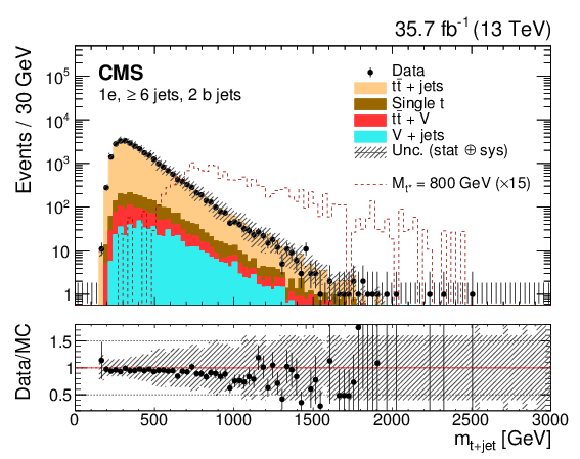
png pdf |
Figure 1-f:
$m_{\rm t+jet}$ distribution of selected events with a single electron and six or more jets of which exactly two are b tagged. Data events (points), simulated background processes (stacked histograms), and a simulated 800 GeV signal process (dashed line) are shown. The shaded region is the total uncertainty of the simulated background processes, which includes statistical and systematic uncertainties. |
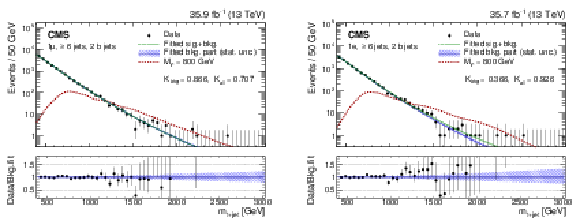
png pdf |
Figure 2:
The $m_{\rm t+jet}$ spectrum in the for data (points), the signal+background fit (green), the background component of the signal+background fit (blue), and the expected spectrum for a simulated 800 GeV signal process (red dashed) normalized to the integrated luminosity of data. Since there is no significant excess of signal found in data, the signal+background curve overlaps the background-only component. The distributions for the $\mu $+jets data are shown on the left while those for e+jets data are shown on the right. The probabilities of the Kolmogorov-Smirnov test between the data versus the signal+background model and between the data versus the background component are denoted by $K_{\text {all}}$ and $K_{\text {bkg}}$, respectively. |

png pdf |
Figure 2-a:
The $m_{\rm t+jet}$ spectrum in the $\mu $+jet final state for data (points), the signal+background fit (green), the background component of the signal+background fit (blue), and the expected spectrum for a simulated 800 GeV signal process (red dashed) normalized to the integrated luminosity of data. Since there is no significant excess of signal found in data, the signal+background curve overlaps the background-only component. The probabilities of the Kolmogorov-Smirnov test between the data versus the signal+background model and between the data versus the background component are denoted by $K_{\text {all}}$ and $K_{\text {bkg}}$, respectively. |
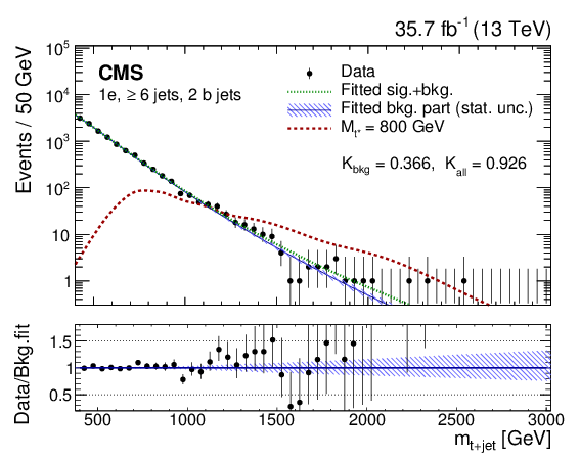
png pdf |
Figure 2-b:
The $m_{\rm t+jet}$ spectrum in the e+jet final state for data (points), the signal+background fit (green), the background component of the signal+background fit (blue), and the expected spectrum for a simulated 800 GeV signal process (red dashed) normalized to the integrated luminosity of data. Since there is no significant excess of signal found in data, the signal+background curve overlaps the background-only component. The probabilities of the Kolmogorov-Smirnov test between the data versus the signal+background model and between the data versus the background component are denoted by $K_{\text {all}}$ and $K_{\text {bkg}}$, respectively. |
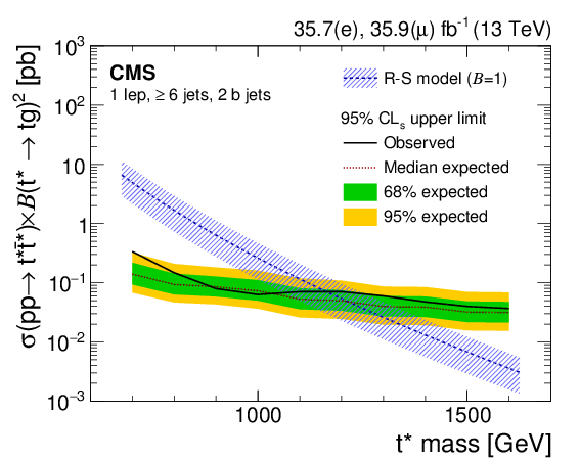
png pdf |
Figure 3:
The expected and observed 95% confidence level upper limits for the product of the production cross section of $ {{{\mathrm{t} {}^{*}}} {{\mathrm{\bar{t}} {}^{*}}}}$ and the square of the branching fraction, as a function of the $ {{\mathrm{t} {}^{*}}} $ mass, for the combined lepton+jets analysis. The theoretical production cross section assuming a 100% $ {{\mathrm{t} {}^{*}}} \to \mathrm{t} \mathrm{g} $ branching fraction is shown along with its uncertainties, described in Section xxxxx. |
| Tables | |

png pdf |
Table 1:
Expected numbers of selected events for the simulated signal process as a function of $ m_{{{\mathrm{t} {}^{*}}}}$. Also shown are the expected numbers of events predicted by the SM, together with the systematic uncertainties discussed in Section xxxxx and the uncertainties in the cross sections of the various processes, as well as the numbers of selected events observed in data. |

png pdf |
Table 2:
Sources of systematic uncertainties and the methods used to evaluate their effect on the simulated signal sample. (s.d.: standard deviation, SF: correction scale factor) |
| Summary |
| A search has been conducted for pair production of spin-3/2 excited top quarks ${{\mathrm{t}{}^{*}}} $ in proton-proton interactions, with each $ {{\mathrm{t}{}^{*}}} $ decaying exclusively to a standard model top quark and a gluon. Events that have a single muon or electron and at least six jets, exactly two of which must be identified as originating from a bottom quark, are selected for the analysis. Assuming $ {{{\mathrm{t}{}^{*}}} {{\mathrm{\bar{t}}{}^{*}}} } $ production, the final-state objects are associated with the $ {{\mathrm{t}{}^{*}}} $ candidates in each event. No significant deviations from standard model predictions are observed in the $\mathrm{t}$+jet system, and an upper limit is set at 95% confidence level on the pair production cross section of $ {{{\mathrm{t}{}^{*}}} {{\mathrm{\bar{t}}{}^{*}}} } $, as a function of the $ {{\mathrm{t}{}^{*}}} $ mass. Interpreting the results in the framework of a spin-3/2 $ {{\mathrm{t}{}^{*}}} $ model, assuming a 100% branching fraction of its decay into a top quark and a gluon, $ {{\mathrm{t}{}^{*}}} $ masses below 1.2 TeV are excluded. These are the best limits to date on the mass of spin-3/2 excited top quarks and the first at 13 TeV. |
| References | ||||
| 1 | H. Georgi, L. Kaplan, D. Morin, and A. Schenk | Effects of top quark compositeness | PRD 51 (1995) 3888 | hep-ph/9410307 |
| 2 | B. Lillie, J. Shu, and T. M. P. Tait | Top compositeness at the Tevatron and LHC | JHEP 04 (2008) 87 | 0712.3057 |
| 3 | A. Pomarol and J. Serra | Top quark compositeness: feasibility and implications | PRD 78 (2008) 74 | 0806.3247 |
| 4 | K. Kumar, T. M. P. Tait, and R. Vega-Morales | Manifestations of top compositeness at colliders | JHEP 05 (2009) 22 | 0901.3808 |
| 5 | U. Baur, M. Spira, and P. M. Zerwas | Excited-quark and -lepton production at hadron colliders | PRD 42 (1990) 815 | |
| 6 | R. M. Harris | Discovery mass reach for excited quarks at hadron colliders | in 1996 DPF / DPB Summer Study On New Directions For High-Energy Physics: Proceedings, Snowmass 1996, volume C960625 1996 | hep-ph/9609319 |
| 7 | ATLAS and CMS Collaborations | Combined measurement of the Higgs boson mass in pp collisions at $ \sqrt{s}= $ 7 and 8 TeV with the ATLAS and CMS experiments | PL14 (2015) 191803 | 1503.07589 |
| 8 | CMS Collaboration | Observation of a new boson at a mass of 125 GeV with the CMS experiment at the LHC | PLB 716 (2012) 30 | CMS-HIG-12-028 1207.7235 |
| 9 | ATLAS Collaboration | Observation of a new particle in the search for the Standard Model Higgs boson with the ATLAS detector at the LHC | PLB 716 (2012) 1 | 1207.7214 |
| 10 | L. Randall and R. Sundrum | An alternative to compactification | PL3 (1999) 4690 | |
| 11 | L. Randall and R. Sundrum | Large mass hierarchy from a small extra dimension | PL3 (1999) 3370 | |
| 12 | B. Hassanain, J. March-Russell, and J. G. Rosa | On the possibility of light string resonances at the LHC and Tevatron from Randall-Sundrum throats | JHEP 07 (2009) 77 | 0904.4108 |
| 13 | W. Rarita and J. Schwinger | On a theory of particles with half-integral spin | PR60 (1941) 61 | |
| 14 | W. J. Stirling and E. Vryonidou | Effect of spin-3/2 top quark excitation on $ \mathrm{t\bar{t}} $ production at the LHC | JHEP 01 (2012) 55 | 1110.1565 |
| 15 | D. A. Dicus, D. Karabacak, S. Nandi, and S. K. Rai | Search for spin-$ 3/2 $ quarks at the Large Hadron Collider | PRD 87 (2013) 15023 | 1208.5811 |
| 16 | B. Moussallam and V. Soni | Production of heavy spin-3/2 fermions in colliders | PRD 39 (1989) 1883 | |
| 17 | CMS Collaboration | Search for pair production of excited top quarks in the lepton+jets final state | JHEP 06 (2014) 125 | CMS-B2G-12-014 1311.5357 |
| 18 | CMS Collaboration | The CMS experiment at the CERN LHC | JINST 3 (2008) | CMS-00-001 |
| 19 | J. Alwall et al. | The automated computation of tree-level and next-to-leading order differential cross sections, and their matching to parton shower simulations | JHEP 07 (2014) 079 | 1405.0301 |
| 20 | NNPDF Collaboration | Parton distributions for the LHC Run II | JHEP 04 (2015) 40 | 1410.8849 |
| 21 | T. Sjostrand et al. | An introduction to PYTHIA 8.2 | CPC 191 (2015) 159 | 1410.3012 |
| 22 | GEANT4 Collaboration | GEANT 4---a simulation toolkit | NIMA 506 (2003) 250 | |
| 23 | P. Nason | A new method for combining NLO QCD with shower Monte Carlo algorithms | JHEP 11 (2004) 40 | hep-ph/0409146 |
| 24 | S. Frixione, P. Nason, and C. Oleari | Matching NLO QCD computations with parton shower simulations: the POWHEG method | JHEP 11 (2007) 70 | 0709.2092 |
| 25 | S. Alioli, P. Nason, C. Oleari, and E. Re | A general framework for implementing NLO calculations in shower Monte Carlo programs: the POWHEG BOX | JHEP 06 (2010) 43 | 1002.2581 |
| 26 | J. M. Campbell, R. K. Ellis, P. Nason, and E. Re | Top-pair production and decay at NLO matched with parton showers | JHEP 04 (2015) 114 | 1412.1828 |
| 27 | H. B. Hartanto, B. Jager, L. Reina, and D. Wackeroth | Higgs boson production in association with top quarks in the POWHEG BOX | PRD 91 (2015) 94003 | 1501.04498 |
| 28 | R. Frederix and S. Frixione | Merging meets matching in MC@NLO | JHEP 12 (2012) 061 | 1209.6215 |
| 29 | J. Alwall et al. | Comparative study of various algorithms for the merging of parton showers and matrix elements in hadronic collisions | EPJC 53 (2008) 473 | 0706.2569 |
| 30 | CMS Collaboration | Particle-flow reconstruction and global event description with the CMS detector | JINST 12 (2017) P10003 | CMS-PRF-14-001 1706.04965 |
| 31 | M. Cacciari, G. P. Salam, and G. Soyez | The anti-$ k_t $ jet clustering algorithm | JHEP 04 (2008) 63 | 0802.1189 |
| 32 | CMS Collaboration | Jet energy scale and resolution in the CMS experiment in pp collisions at 8 TeV | JINST 12 (2017) P02014 | CMS-JME-13-004 1607.03663 |
| 33 | CMS Collaboration | Identification of b-quark jets with the CMS experiment | JINST 8 (2013) P04013 | CMS-BTV-12-001 1211.4462 |
| 34 | CMS Collaboration | Identification of b quark jets at the CMS experiment in the LHC Run 2 | CMS-PAS-BTV-15-001 | CMS-PAS-BTV-15-001 |
| 35 | CMS Collaboration | Description and performance of track and primary-vertex reconstruction with the CMS tracker | JINST 9 (2014) P10009 | CMS-TRK-11-001 1405.6569 |
| 36 | CMS Collaboration | Performance of CMS muon reconstruction in pp collision events at $ \sqrt{s} = $ 7 TeV | JINST 7 (2012) 10002 | CMS-MUO-10-004 1206.4071 |
| 37 | CMS Collaboration | Performance of electron reconstruction and selection with the CMS detector in proton-proton collisions at $ \sqrt{s} = $ 8 TeV | JINST 10 (2015) P06005 | CMS-EGM-13-001 1502.02701 |
| 38 | Particle Data Group, C. Patrignani et al. | Review of particle physics | CPC 40 (2016) 100001 | |
| 39 | K. Cranmer | Kernel estimation in high-energy physics | CPC 136 (2001) 198 | |
| 40 | CMS Collaboration | CMS luminosity measurements for the 2016 data taking period | CMS-PAS-BTV-15-001 | CMS-PAS-BTV-15-001 |
| 41 | ATLAS Collaboration | Measurement of the inelastic proton-proton cross section at $ \sqrt{s} = $ 13 TeV with the ATLAS detector at the LHC | PRL 117 (2016) 182002 | 1606.02625 |
| 42 | T. Junk | Confidence level computation for combining searches with small statistics | NIMA 434 (1999) 435 | hep-ex/9902006 |
| 43 | A. L. Read | Presentation of search results: the $ \text{CL}_\text{s} $ technique | JPG 28 (2002) 2693 | |
| 44 | G. Cowan, K. Cranmer, E. Gross, and O. Vitells | Asymptotic formulae for likelihood-based tests of new physics | EPJC 71 (2011) 1554 | 1007.1727 |
| 45 | ATLAS and CMS Collaboration | Procedure for the LHC Higgs boson search combination in summer 2011 | CMS-NOTE-2011/005, ATL-PHYS-PUB-2011-011 | |

|
Compact Muon Solenoid LHC, CERN |

|

|

|

|

|

|